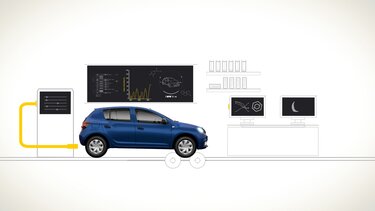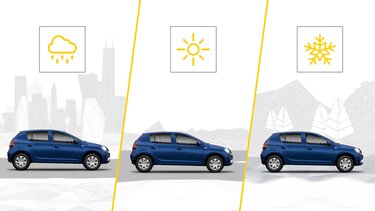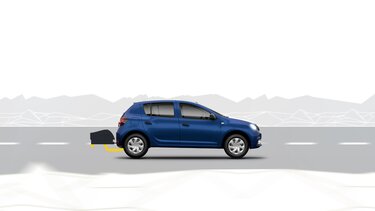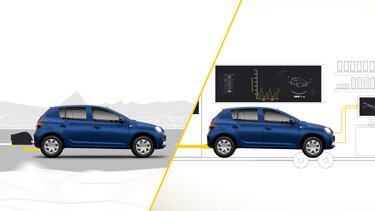Introduction to the new regulations
Lower consumption and emissions by championing efficient and proven solutions
Reducing fuel consumption and pollutant emissions
Reliable and effective solutions
Dacia is committed to making the purchase and use of a new vehicle increasingly affordable. We offer attractive and high-quality vehicles with reliable and effective technologies. Our vehicles are equipped with technologies shared throughout Groupe Renault and thereby benefit from all its expertise to reduce fuel consumption and pollutant emissions.
At Dacia, we help you play an active and simple role in reducing your vehicle's cost of use. As such, we offer you a range of solutions and technologies aimed at reducing fuel consumption and CO2 emissions before, during and after driving, while optimising the use of your vehicle.
Regulations are changing and we play a role in these changes. It begins with taking into account the new Worldwide Harmonised Light Vehicle Test Procedure (WLTP). This new protocol enables consumers to access fuel consumption and pollutant emission data that reflects the everyday use of their vehicle with much more accuracy.
Understanding the changes in regulations: WLTP and RDE
Since 1 September 2017, WLTP has come into effect, gradually replacing the NEDC (New European Driving Cycle) protocol. In addition to this new protocol, there is a second protocol: RDE (Real Driving Emissions). They provide access to consumption and emission results that reflect your actual everyday usage.
Certification protocol
It is a series of mandatory tests that certify the regulatory compliance of all new-to-market vehicles. The goal is to check that all vehicles respect pollutant emission regulations, commonly referred to as emission standards. Euro 6 is the standard currently in effect.
The tests are performed in a laboratory by independent bodies. They are based on standardised driving cycles (length, speed, equipment, temperature, etc.) and measure pollutants, CO2 emissions and fuel consumption for combustion engine vehicles. As such, these measurements let you compare the performance of models from different manufacturers. Today, this data is published in brochures and on manufacturers’ websites.
From NEDC to WLTP
Before September 2017, the NEDC laboratory test – a benchmark since the 1990s – was the certification protocol in effect. This protocol became obsolete as it did not keep up with automotive developments. WLTP gradually replaced NEDC.
So, what's the difference between the two protocols? To begin with, the WLTP driving cycle is longer and more accurate than the NEDC. The test speeds are higher, the temperature range is wider, and all vehicle equipment is taken into account. In short, these improvements produce results that are much closer to what you experience during your everyday journeys.
Comparing NEDC and WLTP
NEDC
- Length of cycle (min): 20
- Distance (km): 11
- Average speed (km/h): 34
- Maximum speed (km/h): 120
- % of time stopped: 24
Results:
Test results are far from real-use conditions.
One result per model/engine/gear box.
Comparing NEDC and WLTP
WLTP
- Length of cycle (min): 30
- Distance (km): 23
- Average speed (km/h): 47
- Maximum speed (km/h): 131
- % of time stopped: 13
Results:
Test results are closer to real-use conditions.
A minimum result and a maximum result for each model/engine/gear box.

As the testing conditions are closer to real-use conditions, they may show higher fuel consumption and emissions compared with brochure information. However, actual daily consumption is not affected. It is simply a more accurate reflection of fuel consumption and emissions which, under WLTP, takes into account the type of vehicle specifically, in addition to the chosen equipment and options. Furthermore, this measurement will be assessed based on a range of results recorded during the test. A vehicle model will thus have several values based on its equipment and options, as opposed to a single result per model for the NEDC protocol.
Real Driving Emissions (RDE)
Even though the conditions of the WLTP test cycles are stricter than those of the NEDC protocol, they still don’t take into account all the parameters of a vehicle's real use, which is where the Real Driving Emissions (RDE) test comes in.
Performed on roads under true driving conditions, this test complements the WLTP certification by verifying a vehicle’s actual pollution emission levels.
Groupe Renault has already begun to provide its customers with the results of RDE pollutant emission tests on new vehicles registered after May 2016.
From 2017 to 2019
From September 2017 to September 2018, all new-to-market vehicles (new model/engine) must be certified under the WLTP test.
From September 2018, all new vehicles sold in dealerships must be certified using WLTP.
From September 2017 until the end of 2018, to simplify the process with respect to customers, regulatory authorities have asked all manufacturers to continue to communicate only the NEDC results. Accordingly, the results of all WLTP-certified vehicles must be converted to their NEDC equivalent until early 2019.
As from January 2019, all published data will be only WLTP values.
By January 2020
In parallel to the implementation of the WLTP certification protocol, the emission standard that vehicles have to respect is evolving step by step to reduce the environmental impact of vehicles. This will ultimately lead to the roll-out of the Euro 6D standard in January 2020.
What this means for you
It’s important to note that both vehicle performance and actual fuel consumption is not affected, regardless of the certification protocol followed.
However, the CO2 levels and fuel consumption data published by manufacturers will naturally increase, since the new WLTP protocol better reflects the vehicle's everyday use.
Simply stated, WLTP is more accurate than NEDC, but it doesn’t change the actual performance or consumption of any vehicle.
Our commitments
Providing you with clear and simple information on the fuel consumption of your vehicles
Transparency and simplicity have always been the Dacia brand's guiding principles.
In early 2018, Dacia thus marketed the first vehicles certified under the new procedure. And since early September 2018, all new Dacia vehicles sold in the networks have had WLTP certification.
Our solutions
Offering you smart solutions for even more savings
With Dacia, you benefit from the best in technology available in Groupe Renault

Technologies aimed at reducing consumption
- On-board features that include a gear change, indicator, an eco-driving mode button, the option of receiving a journey review with an eco-score* and, thanks to eco-coaching*, tips for eco-driving in real time to optimise fuel consumption.
- Stop and Start system aimed at reducing fuel consumption when the vehicle is stationary.
*On All-New Duster only









